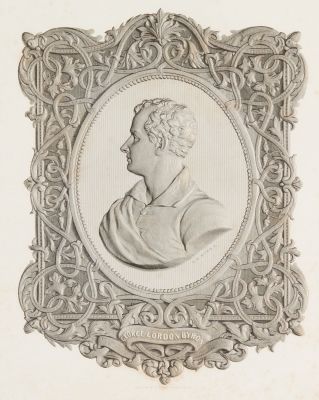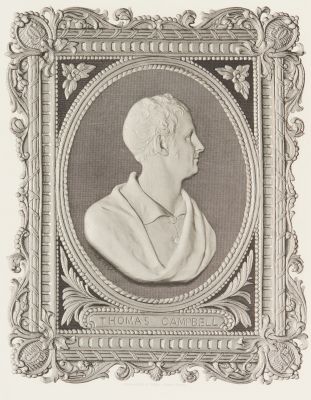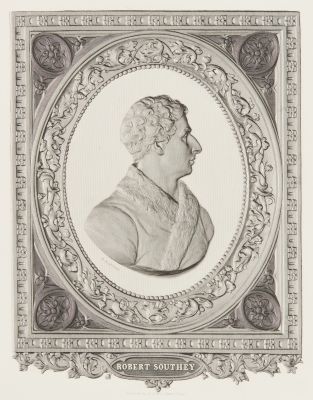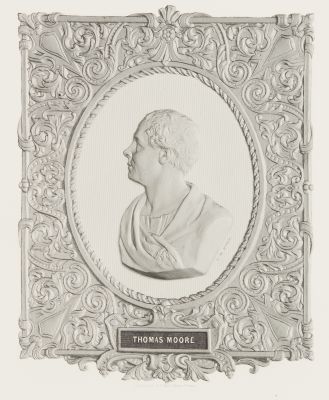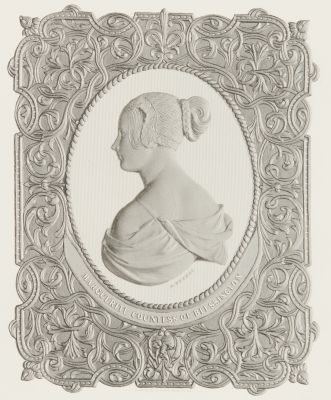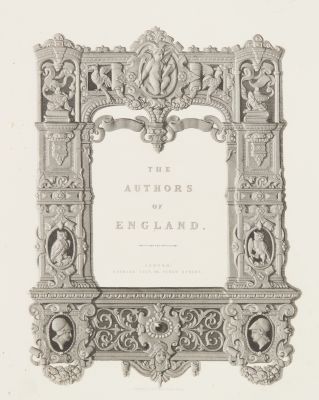
Title
Charles LambArtist
Weekes, H. (British, 1807-1877)Publication
The Authors of England: A Series of Medallion Portraits of Modern Literary CharactersDate
1838Process
AnaglyptographAtelier
Collas, AchilleImage Size
19.5 x 15.7 cmSheet Size
31 x 24 cm
works of art, produced by a new and ingenious process (intro)
This plate is included in The Authors of England: A Series of Medallion Portraits of Modern Literary Characters, Engraved from the Works of British Artists and is produced by the pre-photographic – almost photomechanical process – called Anaglyptography.
Born in Paris in 1795, the industrial designer Achille Collas first came to prominence as the inventor of a machine that carefully copied the relief and chiaroscuro of medallions and other bas-relief objects onto engraved steel plates, producing what Collas called a ‘numismatic engraving’. The anaglyptography process used a tracing arm which moved over a rounded object, such as a plaster cast of a medal, to produce by mechanical means an engraving which had an uncanny appearance of being embossed. Collas first exhibited samples obtained with this procedure at the Paris Salon of 1833 winning widespread acclaim. With the sponsorship of the influential Henriquel Dupont and Paul Delaroche, he embarked on his major project, the Trésor de numismatique et de glyptique (1834-50), a mammoth anthology of engravings of sculpture, reliefs, medals, coins, intaglios and seals.
The nineteenth century was the age of relief medals. They were made to honor notable occasions and famous people, and were cast in multiple copies of great precision and beauty. Anaglyptographs were similar on principal to the pantograph – a machine used in silhouette-making, and to reduce or enlarge drawings and sculptural work. One end of the anaglyptograph ran over the medal and was constrained to run in a straight line only. When the operator raised the tracing stylus by moving it over the relief section of the medal, the line being drawn in the etching ground by the other end of the anaglyptograph was shifted slightly. By running the stylus repeatedly across the medal’s surface, and shifting each line minutely forward from the one before, the printer drew a topographical map of the medal on the prepared plate surface. Once etched, this plate could be inked, wiped, and printed. It is a remarkable process, and only understandable by looking at highly magnified sections. The changing spacing between the lines causes a lightening in areas that rise up on the left of the print; as the form begins to fall off on the right side, the line spacing is reduced and the tone darkens. The increasing and diminishing of the line spaces is perfect, so that the flat surround retains its even gray tone even while the lightening of the head on one side is perfectly compensated for by a darkening on the other.
References
Wakeman Geoffrey. 1973. Victorian Book Illustration: The Technical Revolution. Newton Abbot: David & Charles
Hanson, David Checklist of photomechanical processes and printing 1825-1910, 2017 p. 25
Benson, Richard, and David Frankel. The Printed Picture. New York, NY: The Museum of Modern Art, 2008. p. 92-93 (alt) Also see the video The Printed Picture: Bits and Pieces https://printedpicture.artgallery.yale.edu/bits-and-pieces @5:00
Batchen, Geoffrey. Each Wild Idea: Writing, Photography, History (Cambridge, Mass.; London: MIT Press, 2001)
Buss, Jacques (ed.). Dictionnaire critique et documentaire des peintres, sculpteurs, dessinateurs et graveurs de tous les temps et de tous les pays (Paris: Gründ, 1999)
Dictionnaire de biographie française (Paris: Librairie Letouzey et Ané, 1933- ), IX (1961)
Fawcett, Trevor. ‘Plane Surfaces and Solid Bodies: Reproducing Three-Dimensional Art in the Nineteenth Century’, in Art History through the Camera’s Lens, ed. Helene E. Roberts, introd. Mary Bergstein (Amsterdam: Gordon and Breach, 1995), pp. 59-85.
Nolte, Vincent. ‘Memorial of Facts Connected with the History of Medallic Engraving and the Process of M. Collas’, Museum of Foreign Literature, Science, and Art, 32 (1838), 113-19.
Sobieszek, Robert A. ‘Sculpture as the Sum of Its Profiles: François Willème and Photosculpture in France, 1859-1868’, Art Bulletin, 62 (1980), 617-30.
Thieme, Ulrich, and Felix Becker (eds). Allgemeines Lexikon der Bildenden Künstler: von der Antike bis zur Gegenwart (Leipzig: Seemann, 1907-50)
Victoria and Albert Museum. Art & Design in Europe and America 1800-1900, introd. Simon Jervis (London: Herbert, 1987)
See Literary Gazette 1837 Article about flaws in Collas’ french system and improvements by the British.
